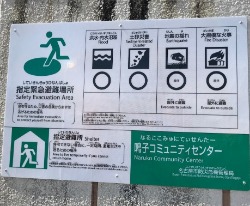In Case of Floods: Tips for Foreigners in Japan
Friday, July 5, 2019
Know where to find information and what to do so that you stay safe during a flood.

Japan is currently experiencing heavy rain, with many regions expected to be hit with a barrage of storms in the near future. Not to mention typhoon season isn’t too far away. There’s no doubt the bad weather will cause flooding, landslides, and a host of other issues for Japan residents. During times like this, foreign residents in Japan might find themselves confused about what to do, where to go, and where they can find more information.
First off, take the advice of The Hitchhiker’s Guide to the galaxy: Don’t panic! Japan has well-established systems for when disasters occur. This article has a few tips for people living in Japan, or thinking about going to Japan, who are worried about what to do in case of floods.
People Visiting Japan
Disaster alerts
· NHK World TV (Apple store, Google play store, Android store)
· Portable News (App store, Google play store)
· Safety tips (App store, Google play store)
Disaster Levels
Japan uses a five-level system to describe disasters, with level 5 being the most dangerous. Understanding what each level means can help understand how serious the situation is. This is a translation of the flood disaster alert levels specified by the Cabinet Office, and some information about them. It is not an official translation. During an emergency, refer to official alerts for information.

*Not an official translation
*The rightmost column has alerts given by the JMA that you’ll see on the TV, news, websites, and other information channels. This alert system is used in many places. Alerts are designated by the following colors in order from least to most severe: yellow, red, purple.
The numbers here correspond with the numbers in red on the image.
① Evacuation Procedures
② Evacuation Information
③(LEVEL 5) There is a disaster in progress. Take any and all precautions to stay safe.
④ (LEVEL 4) Evacuate quickly. If you don’t think it’s safe to go to a public evacuation spot, go to a safe place close by, or a safe space in your house.
⑤ (LEVEL 3) People who need extra time (elderly people, those with disabilities, children, etc) should evacuate. Everyone else should continue evacuation preparations.
⑥ (LEVEL 2) Check your local hazard maps and prepare yourself for evacuations.
⑦ (LEVEL 1) Be wary of the situation worsening.
⑧ Local municipalities will announce information about the disaster as they get it.
⑨ Evacuation advice/Evacuation instructions (during emergencies). Depending on the region and the situation, local municipalities will give emergency announcements, and possibly, calls for evacuation.
⑩ Evacuation preparation. Evacuating the elderly, etc (local municipalities will make announcement)
⑪ Flood warnings, heavy rain warning (The JMA will announce this)
⑫ Early warnings (The JMA will announce this)
⑬ River is overflowing, heavy rain warning
⑭ Danger of river overflowing, landslide warning
⑮ River overflow warning, flood warning
Foreign Residents in Japan
Your local government has got you coveredIf you’re living in Japan, or are going to live in Japan, you should definitely check your local government’s website. It should have all kinds of information about what to do in emergencies, including a system that will allow you to register your Japanese phone to receive messages in case of disasters. Osaka city has a comprehensive page with information about how to prepare for disasters, and a link to a website people can use to search for their nearest evacuation center. When moving to a new location you must go to your local government to register your address, so if you find anything confusing you can ask them first hand.
Hazard maps
Municipalities will have a hazard map that shows safe places to evacuate to during a flood. They might not all be in English, but they are pretty easy to understand, with places likely to flood colored in blue. Here is an example of a hazard map of Mizuho City in Gifu Prefecture, but make sure you check the one of your specific city, town, or village:
A list of Tokyo ward hazard maps can be found here. Unfortunately, only a few are in English.
Japan has also standardized three signs nationwide, one to show an area that might flood, another to designate a safe place in case of floods, and another that shows areas protected against flooding. If you live or are visiting someplace close to a river or ocean, take note of these signs when you seen them.
Take a walk around the block
Signs for evacuation centers generally look something like this:



Trust Your Neighbors and Be Prepared
Keep an eye on the people around you. If sirens go off, pay attention to your surroundings and figure out what your neighbors are doing and where they’re going. Sometimes it’s as simple as that! Make sure you’re aware of your nearby evacuation centers, and have a plan in case a disaster happens. If you have friends or family living in Japan, pass these tips along to them as well.
----------------------------------------------
Sign up here to connect directly with Japanese companies.
Or check out our latest job postings here.
About the Author

I've been in love with Japan since I was twelve years old. After studying at Kansei Gakuin University and teaching for three years under the protection of Mount Tate in scenic Toyama prefecture (where you'll find the most beautiful Starbucks in the world), I returned stateside to attend Kent State University to get my Masters in Japanese Translation. Now I've been given the wonderful opportunity to intern at IZANAU for what's sure to be a glorious summer.









